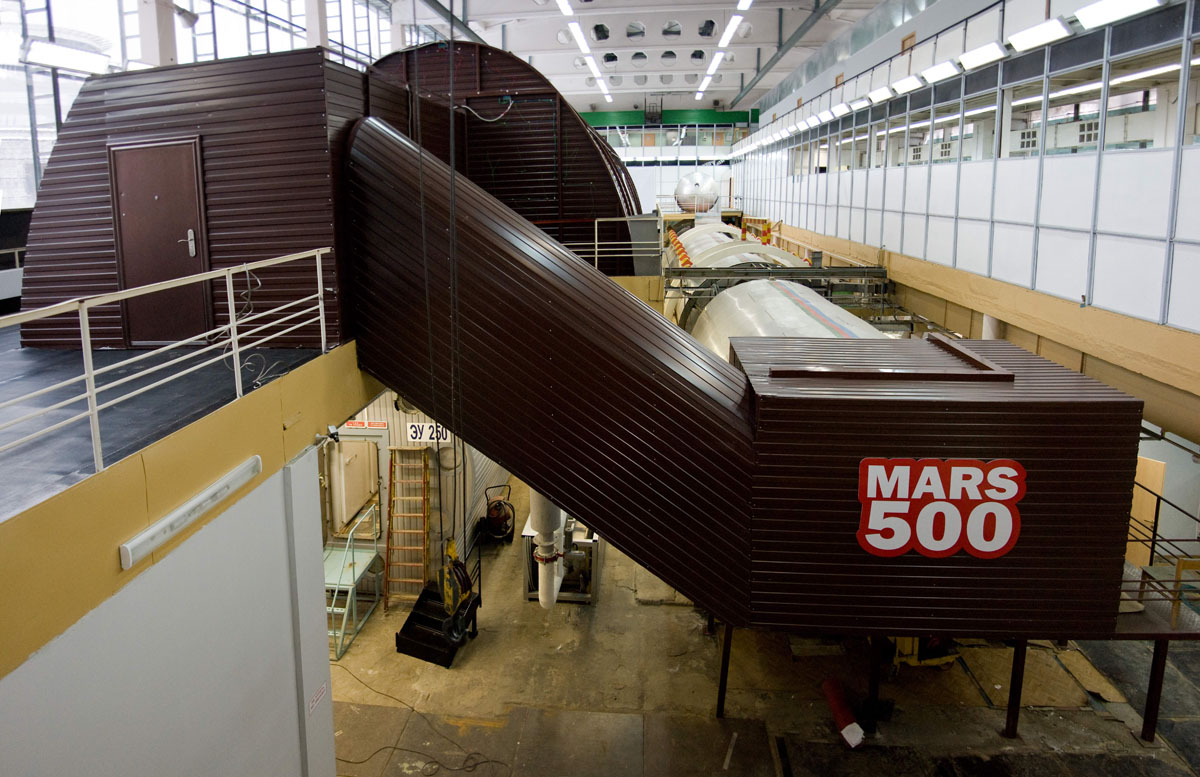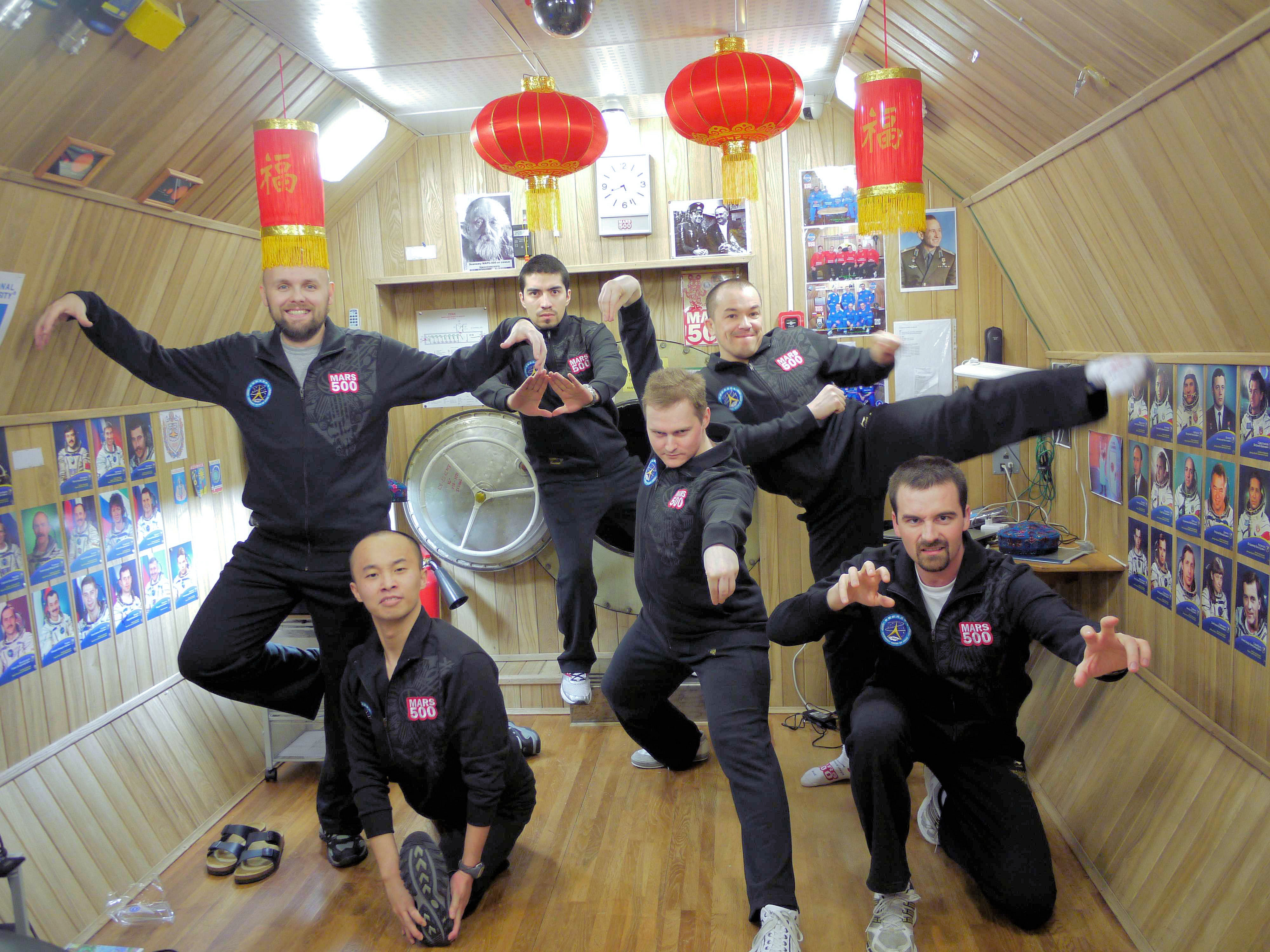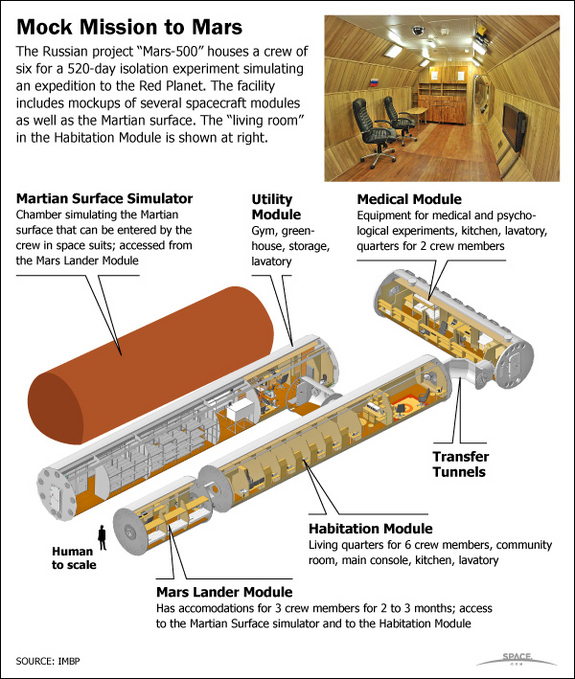Mock Astronauts to 'Walk' on Fake Mars After 'Landing'

An international crew of volunteer astronauts will take their first mock "Mars-walk" today (Feb. 14), kicking their unprecedented 500-day simulation of a mission to the Red Planet into a whole new gear.
The excursion follows the crew's simulated Martian landing on Saturday (Feb. 12). It is the first of three planned Mars-walk simulations during an intensive 10 days of ground exploration. The expedition comes complete with spacesuit-clad astronauts and fake Martian dirt.
For the simulated landing, three members of the six-man crew of the mock Mars mission– an experiment called Mars500 – went through the motions of undocking a lander from their spaceship, plunging through the Martian atmosphere and touching down on the planet's surface – all without ever leaving Earth.
They named their Mars outpost "Gusev Base" after landing.
"Marsonauts are on Mars!" proclaimed the experiment's organizers on Twitter, where they've been posting updates as @Mars_500.
The Martian landing simulation is a major milestone for the Mars500 mission, which began about eight months ago. On June 3, six volunteers – two from Europe, one from China and three from Russia – locked themselves inside a set of connected, windowless modules in Moscow.
The idea is this: Simulate an entire manned mission to Mars, from beginning to end, to better understand the physical and psychological challenges astronauts will face on real deep space journeys. Russia's Institute of Biomedical Problems and the European Space Agency are conducting the experiment, which reportedly costs $15 million.
"The goal is, predict everything we can, prevent anything we can before the mission, detect anything that goes wrong in the mission, and intervene once we've detected it," said David Dinges, a psychology professor at the University of Pennsylvania, in an interview before the landing. Dinges is leading a study attached to the Mars500 project.
Get the Space.com Newsletter
Breaking space news, the latest updates on rocket launches, skywatching events and more!

The mock Mars ship has landed
On Saturday, Russian physiologist Alexandr Smoleevskiy, Italian engineer Diego Urbina and Chinese astronaut trainer Wang Yue simulated the Mars landing. Their crewmates – French engineer Romain Charles and Russians Sukhrob Kamolov (a surgeon) and Alexey Sitev (an engineer) – remained behind on their Mars spacecraft simulator.
"On this experiment the crew has to deal with a lot of different situations – nominal and off-nominal – like driving a manned vehicle or simulating an EVA," Charles wrote in a mission blog entry on Feb. 10. An extravehicular activity, or EVA, is the technical term for missions in spacesuits.

Smoleevskiy and Urbina will make the first Mars-walk mission on Monday while wearing Russian-built Orlan spacesuits. The second mission is scheduled for Friday (Feb. 18) and will be performed by Smoleevskiy and Wang. Smoleevskiy and Urbina will stage the final mock Mars excursion on Feb. 22.
Urbina and Wang will also drive a rover on a simulated Mars surface and use its robotic arm to pick up rocks and sensors, Charles wrote.
The next day, Feb. 23, the trio "launches" back into Mars orbit to rejoin their crewmates for the long simulated trip back to Earth.
The Mars500 experiment's ambitious goals have already won accolades for longtime supporters for a manned mission to Mars.
The Mars Society, for example, lauded Saturday's landing simulation and pointed out that a 500-day experiment is actually longer than a real mission to the Red Planet.
"A human mission to Mars with current-day propulsion requires only 180 days in transit each way. The Mars500 crew has endured isolation for a period significantly longer than that," Mars Society president Robert Zubrin said in a statement. "Their success shows the world that a manned crew can readily endure greater isolation challenges than those associated with a piloted Mars mission, thereby putting to rest the notion that human factors could possibly be a show-stopper barring the way to the Red Planet."

Mars stand-ins on Earth
Simulating crewed missions to Mars or other space destinations is not a new phenomenon. Astronauts and scientists have performed such simulations repeatedly over the years using unforgiving environments including the ocean floor, desert, arctic and Antarctic terrain as stand-ins for Mars.
But when the Mars500 mission is complete, it will be the longest high-fidelity spaceflight simulation in history.
According to the European Space Agency, mission planners have done their best to recreate the minutia of a real Mars mission.
The Mars500 crewmembers are only allowed to shower only once a week and all conversations with their mission control center have a 20-minute time lag to mimic the communications gulf between Earth and Mars, ESA officials have said. The astronauts will each earn about $97,000 for taking part in the experiment.
But just practicing a landing on Mars is not enough. The Mars500 mission crew still has months of isolation ahead during the trip home.
On Feb. 28, the Mars500 crew will load up their "lander" with trash and unneeded items, then abandon the module on March 1, when they are due to leave Mars orbit to simulate the long voyage back to Earth.
The Mars mission simulation will end in early November of this year. By that time, its crew will have undergone about 18 months of isolation inside their Mars spacecraft simulators.
"We need to follow this up with a robust and sustainable multinational effort to send humans to Mars," Zubrin said.
You can follow SPACE.com Managing Editor Tariq Malik on Twitter @tariqjmalik. Senior writer Mike Wall (@michaeldwall) contributed to this report.
Join our Space Forums to keep talking space on the latest missions, night sky and more! And if you have a news tip, correction or comment, let us know at: community@space.com.

Tariq is the Editor-in-Chief of Space.com and joined the team in 2001, first as an intern and staff writer, and later as an editor. He covers human spaceflight, exploration and space science, as well as skywatching and entertainment. He became Space.com's Managing Editor in 2009 and Editor-in-Chief in 2019. Before joining Space.com, Tariq was a staff reporter for The Los Angeles Times covering education and city beats in La Habra, Fullerton and Huntington Beach. In October 2022, Tariq received the Harry Kolcum Award for excellence in space reporting from the National Space Club Florida Committee. He is also an Eagle Scout (yes, he has the Space Exploration merit badge) and went to Space Camp four times as a kid and a fifth time as an adult. He has journalism degrees from the University of Southern California and New York University. You can find Tariq at Space.com and as the co-host to the This Week In Space podcast with space historian Rod Pyle on the TWiT network. To see his latest project, you can follow Tariq on Twitter @tariqjmalik.










